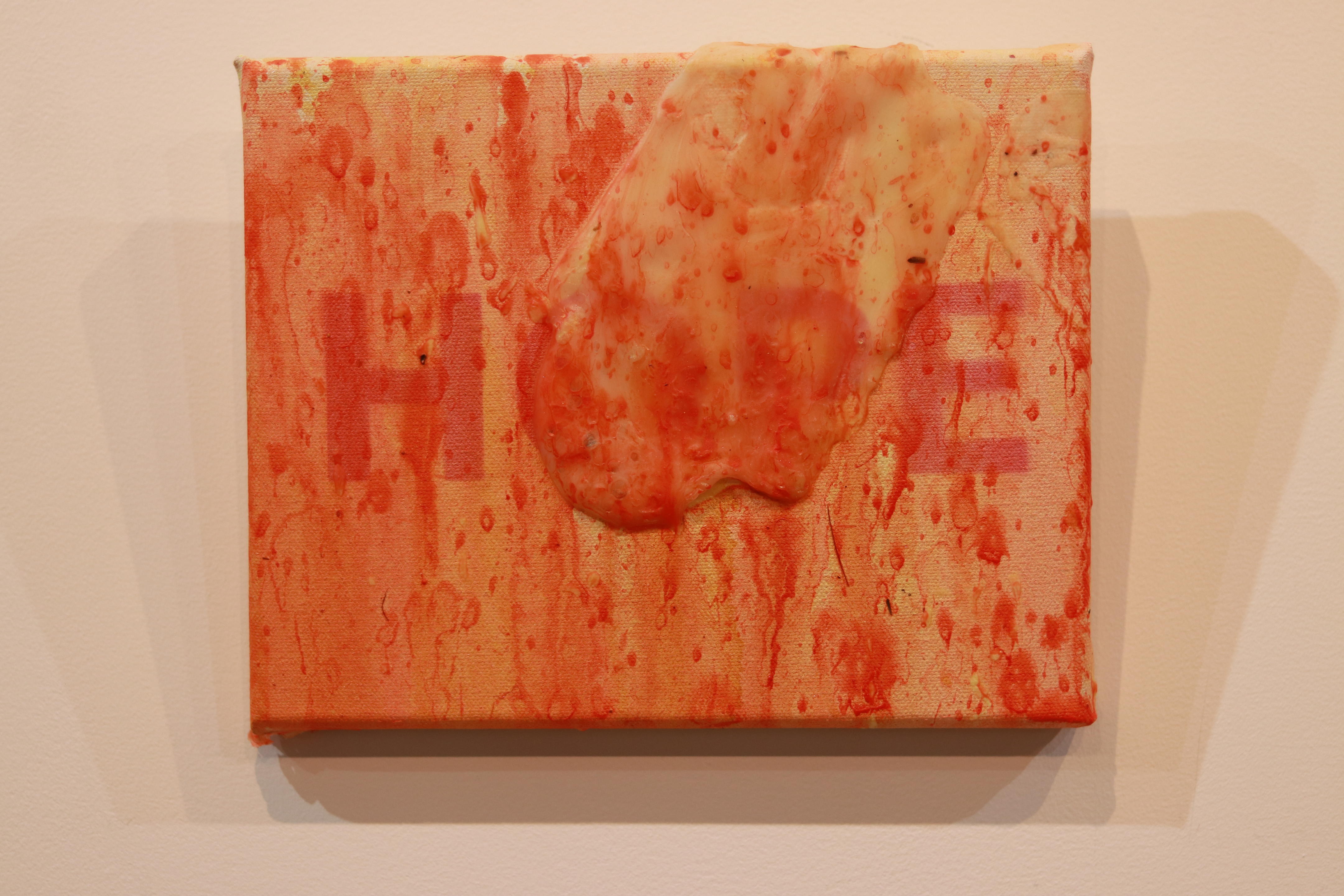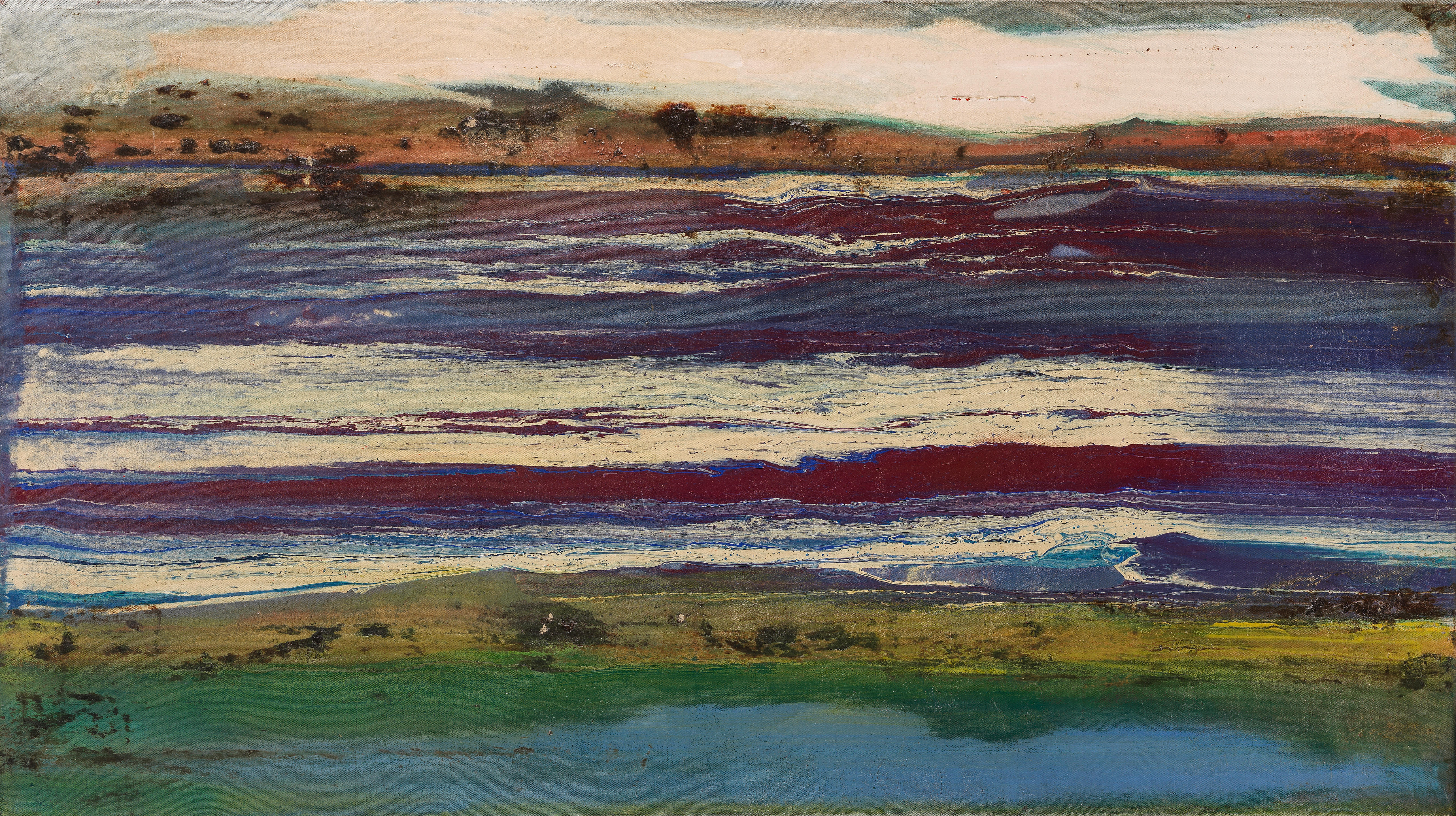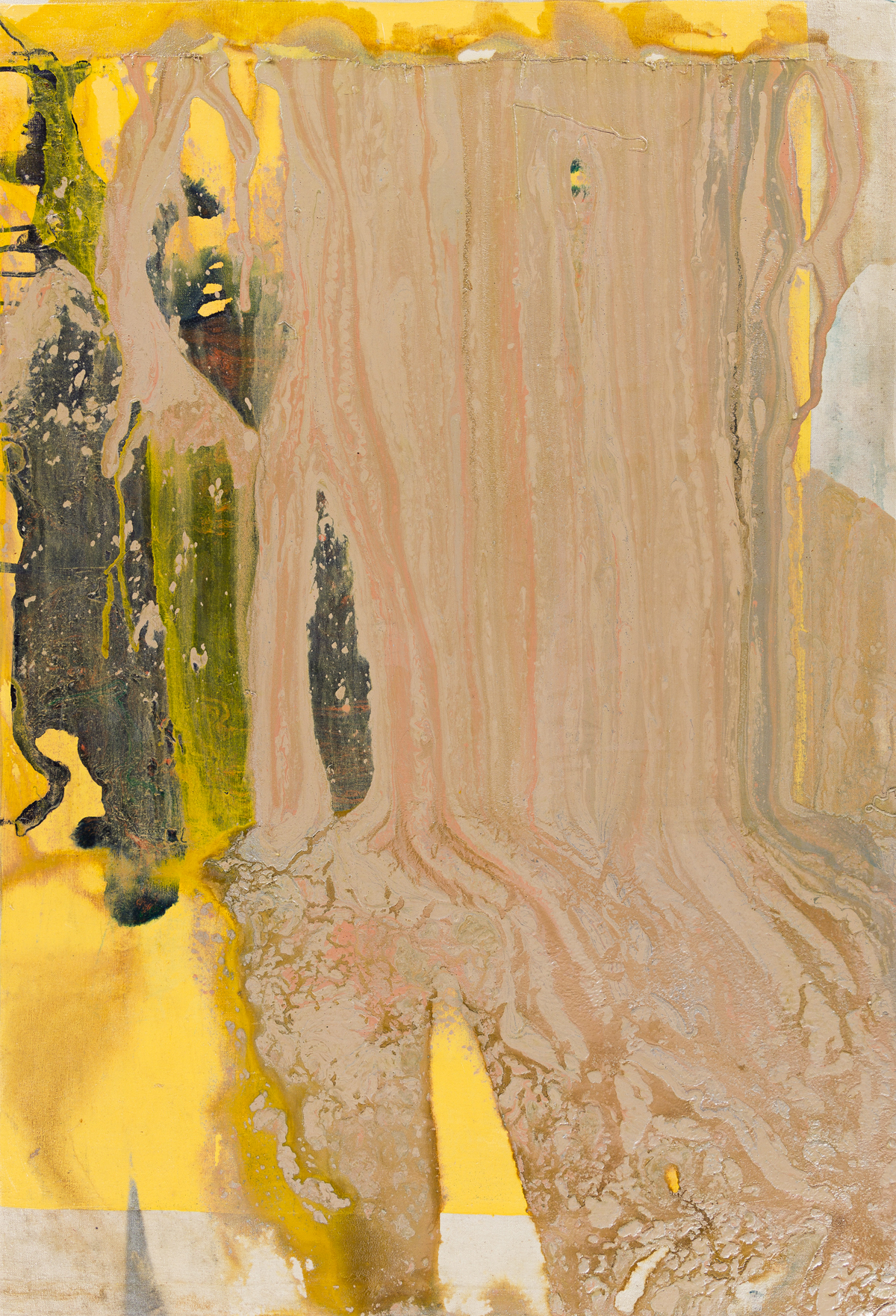Sir Frank Bowling R.A. (British, born 1934)Untitled
acrylic and collage on canvas
60.9 x 91.5 cm. (24 x 36 in.)FootnotesProvenance
The Artist, by whom gifted to the parents of the present owner, circa 1978, thence by family descent
Private Collection, U.K.
Born in what was then British Guyana in 1934, Frank Bowling moved to London aged 19 and after a few years was accepted to study at the Royal College of Art. There he became part of the fabled generation of students (enrolled 1959-1962) whose emergence announced a shift in the prevailing fashion from 1950s abstraction to 1960s pop. His fellow students included Derek Boshier Pauline Boty David Hockney Allen Jones R.B. Kitaj and Peter Phillips Bowling achieved success rapidly with a solo exhibition mounted at the Grabowski Gallery the year he graduated, from which the Arts Council purchased the canvas Birthday (1962), and he was subsequently selected for inclusion in the era-defining photobook Private-View compiled by Bryan Robertson and John Russell in 1965.
Throughout the late 1960s his work embraced a hard-edged pop aesthetic in which dazzling slabs of colour fuse with text, pin-up and screen-printed imagery. Yet Bowling yearned for development. He had first visited New York in 1964 where he met Jasper Johns and Larry Rivers and two years later he relocated to the city. There he quickly began exhibiting with Terry Dintenfass, and before long received the Guggenheim fellowship, allowing him to take a large studio in SoHo. His immersion in New York's colour field painting gave rise to his highly regarded 'Maps' series (1966-1971) in which Bowling combined his by then abstract approach with political and personal concerns. Massive in scale (some span more than 6 meters) they present forms representative of continents, hovering in front of shimmering fields of stained colour. These works featured prominently in his first solo institutional show, staged at the Whitney Museum of American Art in 1971 (when Bowling was aged 37), to much acclaim.
Ever the progressive, his practice developed further in 1973 when he first developed his 'poured' painting method. In his studio Bowling built a wooden platform on which a canvas would be supported. This could then be tilted to allow for the paint, poured from a height, to run down the canvas in a controlled manner. Whilst managing the palette to some extent, this technique purposefully allowed for an element of automatism to enter his work. Curator of the recent and highly celebrated Tate retrospective, Elena Crippa, elaborates; 'Bowling's was the pursuit of an organic interplay between line and medium, so that structure would not be imposed on the unruly plasticity of paint, but found and adopted through the process of making' (Elena Crippa, Frank Bowling exh.cat., Tate Publishing, London, 2019, p.51). This process encapsulates Bowling's fascination with challenging the accepted conventions of painting, which can be traced right from his early works through to his present practice.
In 1975 Bowling returned to London, which would act as his primary base for the next fifteen years. Working at first from a studio above St. Anselm's Church in Kennington, he continued to develop his 'poured' paintings. Whilst the 'Maps' series that immediately proceeded them addressed Bowling's global concerns, the poured paintings from the mid-70s are arguably more personal. Many derive their title from Guyanese locations such as Potaroway (1975, sold in these rooms on 30th June 2021 for £237,750), which takes its name from the Potaro, the vast river which winds its way 140 miles east from its source at Mount Ayanganna. Similarly, the Government Art Collection's Kaieteurtoo (1975) titled after the famous waterfall situated on the Potaro, and Bartica Bressary (1978-9, Private Collection) named after Bowling's birth town.
Seen here in public for the first time since its gifting to the present owner's parents in the late 1970s, Untitled is an intriguing example of the artist's painting technique and sparkles with interest. Bowling demonstrates his mastery of colour with a fusion of orange, yellow, pink and green, brought together with an assured command of flow, density and contrast across the canvas. As with the aforementioned Potaroway, Bowling has adopted a horizontal composition rather than his more common vertical format and and a sense of defined landscape emerges from his action led process.
In 1987 Bowling made history as the first artist of afro-Caribbean descent to have their work enter the Tate Collection and again in 2005 when he was elected the first black Royal Academician in the institution's history. Sir Frank Bowling was awarded a knighthood in the Queen's birthday honours, 2020, aged 86.
We are grateful to the Frank Bowling Studio for their assistance in cataloguing this lot.Read MoreAdditional informationAuction informationBuyers' ObligationsALL BIDDERS MUST AGREE THAT THEY HAVE READ AND UNDERSTOOD BONHAMS' CONDITIONS OF SALE AND AGREE TO BE BOUND BY THEM, AND AGREE TO PAY THE BUYER'S PREMIUM AND ANY OTHER CHARGES MENTIONED IN THE NOTICE TO BIDDERS. THIS AFFECTS THE BIDDERS LEGAL RIGHTS.If you have any complaints or questions about the Conditions of Sale, please contact your nearest customer services team.Buyers' Premium and ChargesFor all Sales categories, buyer's premium excluding Cars, Motorbikes, Wine, Whisky and Coin & Medal sales, will be as follows: Buyer's Premium Rates
28% on the first £40,000 of the hammer price;
27% of the hammer price of amounts in excess of £40,000 up to and including £800,000;
21% of the hammer price of amounts in excess of £800,000 up to and including £4,500,000;
and 14.5% of the hammer price of any amounts in excess of £4,500,000.VAT at the current rate of 20% will be added to the Buyer's Premium and charges excluding Artists Resale Right.Payment NoticesFor payment information please refer to the sale catalog.Shipping NoticesFor information and estimates on domestic and international shipping as well as export licences please contact Bonhams Shipping Department.Lot SymbolsARArtists Resale RightGoods subject to Artists Resale Right Additional Premium.Related DepartmentsModern British & Irish ArtAuction ViewingsLondon, New Bond Street15 June 2023, 09:00 - 17:00 BST16 June 2023, 09:00 - 17:00 BST17 June 2023, 11:00 - 15:00 BST18 June 2023, 11:00 - 15:00 BST19 June 2023, 09:00 - 16:00 BST20 June 2023, 09:00 - 17:00 BST21 June 2023, 09:00 - 13:00 BSTConditions of SaleView Conditions of Sale
Sir Frank Bowling R.A. (British, born 1934)Untitled
acrylic and collage on canvas
60.9 x 91.5 cm. (24 x 36 in.)FootnotesProvenance
The Artist, by whom gifted to the parents of the present owner, circa 1978, thence by family descent
Private Collection, U.K.
Born in what was then British Guyana in 1934, Frank Bowling moved to London aged 19 and after a few years was accepted to study at the Royal College of Art. There he became part of the fabled generation of students (enrolled 1959-1962) whose emergence announced a shift in the prevailing fashion from 1950s abstraction to 1960s pop. His fellow students included Derek Boshier Pauline Boty David Hockney Allen Jones R.B. Kitaj and Peter Phillips Bowling achieved success rapidly with a solo exhibition mounted at the Grabowski Gallery the year he graduated, from which the Arts Council purchased the canvas Birthday (1962), and he was subsequently selected for inclusion in the era-defining photobook Private-View compiled by Bryan Robertson and John Russell in 1965.
Throughout the late 1960s his work embraced a hard-edged pop aesthetic in which dazzling slabs of colour fuse with text, pin-up and screen-printed imagery. Yet Bowling yearned for development. He had first visited New York in 1964 where he met Jasper Johns and Larry Rivers and two years later he relocated to the city. There he quickly began exhibiting with Terry Dintenfass, and before long received the Guggenheim fellowship, allowing him to take a large studio in SoHo. His immersion in New York's colour field painting gave rise to his highly regarded 'Maps' series (1966-1971) in which Bowling combined his by then abstract approach with political and personal concerns. Massive in scale (some span more than 6 meters) they present forms representative of continents, hovering in front of shimmering fields of stained colour. These works featured prominently in his first solo institutional show, staged at the Whitney Museum of American Art in 1971 (when Bowling was aged 37), to much acclaim.
Ever the progressive, his practice developed further in 1973 when he first developed his 'poured' painting method. In his studio Bowling built a wooden platform on which a canvas would be supported. This could then be tilted to allow for the paint, poured from a height, to run down the canvas in a controlled manner. Whilst managing the palette to some extent, this technique purposefully allowed for an element of automatism to enter his work. Curator of the recent and highly celebrated Tate retrospective, Elena Crippa, elaborates; 'Bowling's was the pursuit of an organic interplay between line and medium, so that structure would not be imposed on the unruly plasticity of paint, but found and adopted through the process of making' (Elena Crippa, Frank Bowling exh.cat., Tate Publishing, London, 2019, p.51). This process encapsulates Bowling's fascination with challenging the accepted conventions of painting, which can be traced right from his early works through to his present practice.
In 1975 Bowling returned to London, which would act as his primary base for the next fifteen years. Working at first from a studio above St. Anselm's Church in Kennington, he continued to develop his 'poured' paintings. Whilst the 'Maps' series that immediately proceeded them addressed Bowling's global concerns, the poured paintings from the mid-70s are arguably more personal. Many derive their title from Guyanese locations such as Potaroway (1975, sold in these rooms on 30th June 2021 for £237,750), which takes its name from the Potaro, the vast river which winds its way 140 miles east from its source at Mount Ayanganna. Similarly, the Government Art Collection's Kaieteurtoo (1975) titled after the famous waterfall situated on the Potaro, and Bartica Bressary (1978-9, Private Collection) named after Bowling's birth town.
Seen here in public for the first time since its gifting to the present owner's parents in the late 1970s, Untitled is an intriguing example of the artist's painting technique and sparkles with interest. Bowling demonstrates his mastery of colour with a fusion of orange, yellow, pink and green, brought together with an assured command of flow, density and contrast across the canvas. As with the aforementioned Potaroway, Bowling has adopted a horizontal composition rather than his more common vertical format and and a sense of defined landscape emerges from his action led process.
In 1987 Bowling made history as the first artist of afro-Caribbean descent to have their work enter the Tate Collection and again in 2005 when he was elected the first black Royal Academician in the institution's history. Sir Frank Bowling was awarded a knighthood in the Queen's birthday honours, 2020, aged 86.
We are grateful to the Frank Bowling Studio for their assistance in cataloguing this lot.Read MoreAdditional informationAuction informationBuyers' ObligationsALL BIDDERS MUST AGREE THAT THEY HAVE READ AND UNDERSTOOD BONHAMS' CONDITIONS OF SALE AND AGREE TO BE BOUND BY THEM, AND AGREE TO PAY THE BUYER'S PREMIUM AND ANY OTHER CHARGES MENTIONED IN THE NOTICE TO BIDDERS. THIS AFFECTS THE BIDDERS LEGAL RIGHTS.If you have any complaints or questions about the Conditions of Sale, please contact your nearest customer services team.Buyers' Premium and ChargesFor all Sales categories, buyer's premium excluding Cars, Motorbikes, Wine, Whisky and Coin & Medal sales, will be as follows: Buyer's Premium Rates
28% on the first £40,000 of the hammer price;
27% of the hammer price of amounts in excess of £40,000 up to and including £800,000;
21% of the hammer price of amounts in excess of £800,000 up to and including £4,500,000;
and 14.5% of the hammer price of any amounts in excess of £4,500,000.VAT at the current rate of 20% will be added to the Buyer's Premium and charges excluding Artists Resale Right.Payment NoticesFor payment information please refer to the sale catalog.Shipping NoticesFor information and estimates on domestic and international shipping as well as export licences please contact Bonhams Shipping Department.Lot SymbolsARArtists Resale RightGoods subject to Artists Resale Right Additional Premium.Related DepartmentsModern British & Irish ArtAuction ViewingsLondon, New Bond Street15 June 2023, 09:00 - 17:00 BST16 June 2023, 09:00 - 17:00 BST17 June 2023, 11:00 - 15:00 BST18 June 2023, 11:00 - 15:00 BST19 June 2023, 09:00 - 16:00 BST20 June 2023, 09:00 - 17:00 BST21 June 2023, 09:00 - 13:00 BSTConditions of SaleView Conditions of Sale

.jpg)

.jpg)

.jpg)
.jpg)








Testen Sie LotSearch und seine Premium-Features 7 Tage - ohne Kosten!
Lassen Sie sich automatisch über neue Objekte in kommenden Auktionen benachrichtigen.
Suchauftrag anlegen